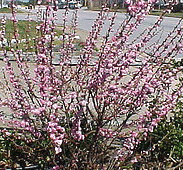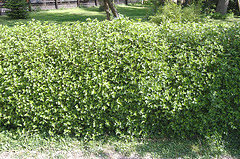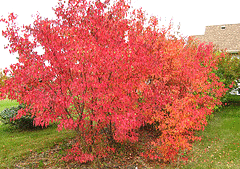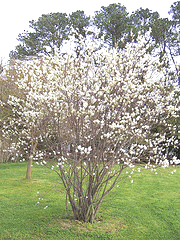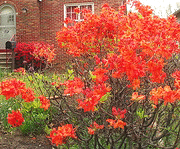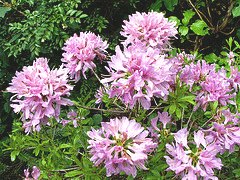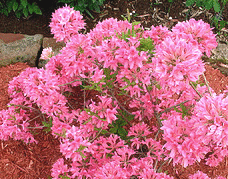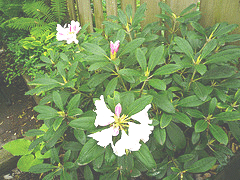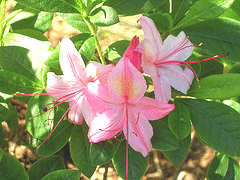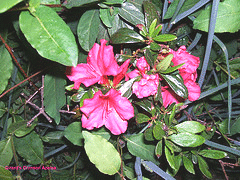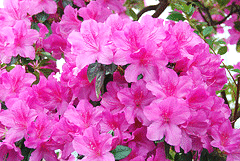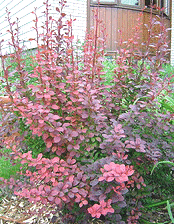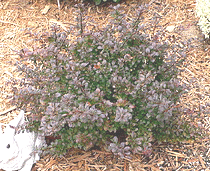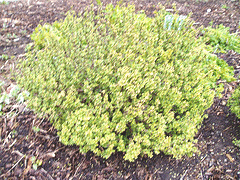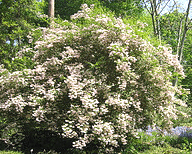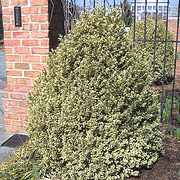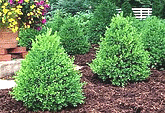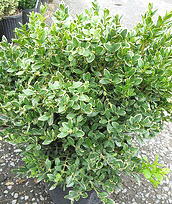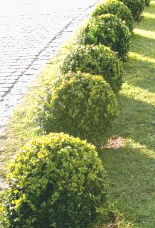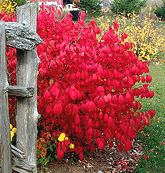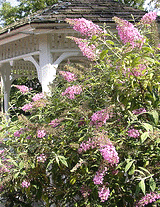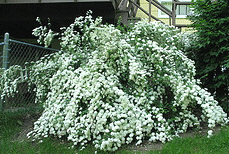Best Performing Hardy Shrubs for Northern and Midwest Climates
Best performing, in this case, is not relative to blooming qualities. Although there are many hardy flowering shrubs for the bloom starved northern gardens, shrubs are part of the structure of a garden or landscape.
They need to fill sunny, shady, dry, moist or windy areas, and thrive with minimal attention. They may need to provide a backdrop, texture, color, or a transition between garden areas.
When selecting shrubs, think carefully about what you are trying to accomplish. Listed here are some of the most reliable hardy deciduous shrubs, which are those with woody branches that typically lose their leaves in winter.
Some of these shrubs you will also find listed as hardy perennials, primarily because their blooming qualities and smaller stature lend themselves well to the northern garden with minimal care.
Flowering Almond (Prunus glandulosa & trileba)
Needs full sun
Hardy in zones 4-9
A Flowering shrub
Although prunus includes large fruiting trees, there are several species that are "dwarf" shrubs (dwarf is relative, for a shrub, these are not small).
They bloom generally in late April before the leaves open. 'Rosplena' has double pink blooms and grows to 5 feet. 'Multiplex' has 1-inch pink 'pompom' blooms and grows to 8 feet.
If pruning is required, do it after the blooms have faded for best blooming next year. These two are hardy to zone 4. Winter protection is advised. Cultivars may or may not produce fruit.
Almonds will do best in moist, well-drained soil. They can be prone to a variety of diseases, as well as mice damage.
Alpine Currant (Ribes Alpinum)
Full sun to shade
Hardy in zones 2-7
Alpine currant is highly favored as a hedging plant due to its numerous benefits. Its ability to withstand cold temperatures and adapt to various conditions makes it a desirable choice.
Frequent trimming is easily managed and results in a tidy hedge. It is also highly resistant to diseases and maintains a healthy appearance with its shiny, dark green leaves.
Although it prefers moist, well-drained soil, it can survive in dry and alkaline soil and is highly tolerant of wind.
Read more: Shrubs for Moist Soil
With slightly horizontal branching and a natural mound shape, it grows steadily, but shearing for a hedge can be minimized. The plant produces bright red fruit in midsummer, but both male and female plants must be present for pollination, and most retail cultivars are male and will not bear fruit.
The plant typically grows to 3-5 feet in height and 5-6 feet in width, with the ‘Green Mound’ variety being slightly smaller, reaching about 3 feet in both height and width.
Amur Maple (Acer ginnala)
Full sun to part shade
Hardy in zones 3-6
This large and sturdy shrub is known for its durability, especially during fall when it transforms into a stunning display of yellow and red hues. It prefers moist and well-drained soils, but can still survive in dry conditions.
'Embers' variety boasts the brightest red foliage during autumn, while 'Flame' produces clusters of seeds, adding winter interest. Both varieties are tolerant of a wide range of conditions and can be planted in masses for an excellent screening effect.
Though capable of reaching 20 feet in height and width, these shrubs can be pruned to increase density. 'Bailey Compact' is a more condensed option with a rounded shape and fine branching. It grows up to 7-8 feet high and wide, suitable for borders, hedges, or foundation plantings.
Its fall color is an exceptional scarlet. 'Emerald Elf' is even smaller, growing only 5-6 feet in height and width. It has a slow growth rate and displays red-plum foliage during fall.
Amelanchier canadensis (Serviceberry, Shadbush)
Sun, part shade or shade
Hardy in zones 4-8
A Flowering Shrub
This shrub is known for its white spring flowers and strong upright growth. Its shape makes it easy to prune into a tree form or for hedges and screens.
In fall, it displays a stunning red color. It can grow up to 20 feet in height and 5-8 feet in width. For those who prefer a smaller version, the Amelanchier aninifolia is a great option.
This rounded shrub is perfect for border planting or foundations. It features white flower clusters in early spring, followed by sweet and delicious dark fruits that birds and humans alike love. Even in shade, it produces fall colors ranging from yellow to orange to red. Aninifolia is hardy in zones 2-7.
Read more on Serviceberry Shrubs
Azalea (Rhododendron canescens)
Sun to part shade
Hardy in zones 4-9
A Flowering shrub
Azalea is a shade-loving flowering shrub that can grow in both shade and part sun. It is a popular spring perennial due to its stunning blooms and various types.
Azaleas should not be planted too deep as they have shallow roots. These shrubs prefer cool, moist, organic soil and require ample water to thrive. Rhododendrons and Azaleas grow best in well-drained, moist, acidic soil.
The 'Lights' series of Azaleas are hardy for colder northern winters and can be planted up to Zone 4 with minimal damage.
Rhododendrons are susceptible to early freeze damage, and applying an anti-transpirant in December and February can prevent drying out from winter winds.
Read more on Rhododendrons and Azaleas here.
Azalea ‘Golden Lights’
Hardy in zones 4-9
Golden Lights is a mildew-resistant azalea hybrid that produces stunning golden blooms in late spring.
The shrub is covered in clusters of 1-inch golden orange flowers, and its leaves turn bronzy in the fall.
It can be grown in either full sun or partial shade, and it has better mildew resistance than most azalea hybrids.
Under optimal conditions, Golden Lights can reach a height of 6 feet and a width of 5 feet, although it may not grow as large in Zone 4.
Azalea ‘Mandarin Lights’
Hardy in zones 4-8
‘Mandarin Lights’ blooms in early spring and is very floriferous.
Bright orange blooms are slightly ruffled and lightly fragrant. It is a large azalea, 6-8 feet tall and about 4 feet wide, with an upright and rounded growth habit. Foliage turns bronze in autumn. It grows well in full to part sun.
Azalea ‘Northern Hi-Lights’
Hardy in zones 4-7
‘Northern Hi-Lights’ is very fragrant, with creamy white flowers that have a yellow upper petal.
It blooms in May to early June. This azalea grows relatively slowly, reaching about 4 feet high and 5 feet wide. The foliage is somewhat mildew resistant.
Azalea ‘Orchid Lights’
Hardy in zones 4-7
‘Orchid Lights’ is very cold hardy. This compact dwarf reaches only 2-3 feet high and wide.
Orchid-colored blooms are 1 1/2 “ across and are sterile, so no seed pods are produced.
‘Orchid Lights’ blooms two weeks before other ‘Lights’ azaleas in early May. They grow well in sun to part shade.
Azalea ‘Rosy Lights’
Hardy in zones 4-7
‘Rosy Lights’ has very fragrant flowers. They bloom floriferous with deep rosy pink flowers.
Blooms appear from May to early June.
This is a large azalea that reaches up to 8 feet in ideal conditions but generally will remain about 5 feet high and 5-6 feet wide. Grows well in sun to part shade.
Azalea ‘Yaku Princess’
Hardy in zones 5-9
‘Yaku Princess’ is hard to find and not quite as hardy as ‘Golden Lights’, but may make it in zone 4 with protection.
Blooms are apple blossom pink, maturing to a light blush, in May and June.
It prefers part shade to sun and reaches 3 feet high and 4 feet wide.
Flower buds develop over the summer, so should be protected with snow to preserve the blooms for next spring.
Azalea ‘Weston’s Lollipop’
Hardy in zones 4-9
‘Weston’s Lollipop’ is smaller in size and can do well in zone 4.
‘Weston’s Lollipop’ has a sweet scent with rich pink blooms with a bold yellow marking.
Bloom time is later than most Azaleas, with blooms sometimes lasting well into summer. Foliage turns wonderfully red and orange in autumn.
Mildew and pet resistant, it grows well sun to part shade. Reaches 3’ high and 5’ wide.
Azalea ‘Girard’s Crimson’
Hardy in zones 5-8
‘Girard’s Crimson’ is one of the hardy, evergreen Girard’s hybrids.
It produces a spectacular display of rosy red blooms 2 1/2” in diameter in early May.
Glossy green foliage with dense, compact growth and nice maroon winter color. It will grow well in part sun to part shade, preferring well-drained soil
This compact plant reaches 3 feet high and 2 feet wide.
Azalea ‘Girard’s Fuschia’
Hardy in zones 5-8
‘Girard’s Fuschia’ is also one of the hardy evergreen hybrids.
It produces a stunning display of gorgeous fuschia blooms.
Glossy dark green evergreen foliage turns maroon in fall. It prefers part sun to part shade.
With a dense, compact growing habit, mature size is 3 feet high and 3-4 feet wide.
Barberry (Berberis thunbergii)
Full sun to part shade
Hardy in zones 4-8
The Japanese Barberry, or Berberis, is a well-known and commonly used shrub. In shaded areas, the purple cultivars will appear greener. Japanese Barberry can tolerate various soil conditions except for very wet soil and can also withstand dry, windy areas.
Due to their compact growth habit, they are suitable for foundation plantings, borders, and as specimen plants. Varieties that grow larger can be used for hedging and creating thorny barriers.
Related: Plants to Grow from Cuttings
These thorny bushes are typically not attractive to deer and rabbits, and a dense hedge may even deter them from entering. Barberry transplants easily and can produce sucker shoots, which may not be an issue in smaller shrubs.
Most Barberry varieties produce fruits/seeds, which have led to issues with invasive spreading. However, some varieties, such as 'Concorde', 'Bonanza Gold', 'Kobold', and 'Gold Nugget' produce few or no seeds.
‘Crimson Pygmy’ (Berberis thunbergii atropupurea)
Full sun to part shade
Hardy in zones 4-7
'Crimson Pygmy' is a popular choice in northern regions due to its attractive deep burgundy red foliage and compact, mounded shape.
It only grows to a height of 2 feet and a width of 2-3 feet, making it ideal for small spaces or as an accent plant to complement greenery. The foliage of 'Crimson Pygmy' appears lighter red to green in shaded areas.
Although it produces small spring flowers, they are barely noticeable, and it develops fruit that persists throughout the winter. This variety is also known for its small thorns.
‘Rosy Glow’ (Berberis thunbergii atropupurea)
Full sun to part shade
Hardy in zones 4-7
Similar to 'Crimson Pygmy', 'Rosy Glow' is a slightly larger barberry variety with vibrant burgundy foliage that features pink and rosy new growth that eventually matures to a burgundy shade.
It can grow up to 3-4 feet in height and 2-3 feet in width, making it suitable as a specimen plant, for massing, or as a low hedge. Its compact growth is also ideal for foundation plantings in limited space.
In shaded areas, the foliage of 'Rosy Glow' will appear greener. This variety is also thorny.
‘Golden Nugget’ (Berberis thunbergii)
Full sun to part shade
Hardy in zones 4-7
'Gold Nugget' is a compact Japanese Barberry variety that only grows to 12-15" in height and about 24" in width. Its small golden leaves feature orange highlights and are resistant to sun scorch and disease.
The foliage turns orange in the fall. 'Gold Nugget' is very drought-resistant in partial shade to shade and its foliage may appear more yellow-green in such conditions. It requires more water in full sun.
This variety is equipped with many thorns, making it an excellent deterrent for pets and deer. The larger version of 'Gold Nugget' is 'Sunsation', which can reach a height of 3 feet and a width of 4 feet. The brand new 'Gold Beret' is even smaller than 'Gold Nugget', growing only up to 6-12" in height and width.
Hints of red can be observed in its new growth, and its foliage turns orange-red in the fall. 'Gold Beret' thrives in full sun, is drought-resistant, and is scorch-resistant. It never needs pruning and is perfect for very small spaces and containers.
‘Gold Ring’ (Berberis thunbergii atropurpurea)
Full sun to part shade
Hardy in zones 4-8
The red-purple foliage of 'Gold Ring' is accentuated by golden ochre margins, and full sun exposure brings out the best color, revealing stunning leaves up close. From afar, this variety appears as red-burgundy.
'Gold Ring' grows to a height and width of approximately 4 feet or more, displaying a rounded form. It produces black edible berries that are quickly consumed by birds.
Beautybush (Kolkwitzia amabalis)
Full sun
Hardy in zones 5-8
A Flowering shrub
If you have ample space to showcase the arching branches of this 10-foot flowering shrub, Beautybush is an excellent choice as a large specimen plant. During June, it becomes adorned with thousands of small pink flowers.
Though Beautybush can be pruned to maintain a smaller size, this practice can cause it to lose the natural charm of its form. It grows best in soils that are moist and well-drained. To promote healthy growth and maintain its shape, some old stems should be removed from the bush annually.
Boxwood (Buxus)
Full sun to part shade
Hardy in zones 5-8
Boxwood is a dense evergreen shrub with emerald waxy foliage. Both Korean and English Boxwoods have been widely used for hedges and can be sheared into a beautiful dense form. While English Boxwood is the larger of the two, growing up to 15-20 feet, the hybrids crossed between Korean and English have blurred the lines. Hence, look for the hardiness and size that you require.
Buxus sempervirens 'Aureovariegata' is a tall variety that shears well into a conical shape, growing up to 8-10 feet tall and up to 6 feet wide. It has slightly mottled yellow and green leaves and is hardy only up to zone 6. The Green Tower is a columnar Boxwood variety that is perfect for topiary.
‘Winter Gem' is a dwarf form of the common boxwood, with darker mature foliage (new growth is bright) and better cold hardiness. It grows in a dense and uniformly rounded habit, reaching about 3 feet.
Several Boxwood varieties are small and rounded, approximately 2-4 feet, making them excellent for hedging or foundation plants. To keep their root systems moist and cool, apply mulch, and protect their evergreen foliage from drying winds in winter, which can cause winter burn and sunscald. Water thoroughly until the ground freezes to help the plant properly acclimate to winter. Evergreen Boxwoods are susceptible to dessication (drying out from winter winds and lack of moisture).
Applications of an anti-transpirant in December and February can help prevent the foliage from drying out, turning brown, and dropping off. For gardens in more northern regions, look for the Boxwood Wintergreen, which grows well in zone 4 and is less prone to winter discoloration. It is a Korean Boxwood that requires full sun to part shade and is hardy in zones 4-9. Its foliage is yellow-green, and it has a dense rounded form that reaches 2-4 feet in height and 3-5 feet in width.
‘Green Velvet’ is also hardy in zones 4-9, growing low and rounded with dark green foliage year-round, although not quite as large as the ‘Wintergreen.’ It grows up to 2-3 feet in height and approximately 3 feet in width.
‘Green Mountain’ is a wonderful conical-shaped boxwood that is also hardy in zones 4-7. Its shape is natural but may require minor shearing to maintain a 'perfect' form. The small, bright green leaves are evergreen, and 'Green Mountain' grows quickly in its early years, eventually reaching about 4 feet in height and 3 feet in width.
Boxwoods are relatively low-maintenance deciduous evergreens and require average water, growing fairly slowly. Both sandy and clay soils of average pH, slightly alkaline to acidic, are acceptable. Select a site protected from winter winds to avoid winter burn, and ensure winter afternoon shading to avoid sunscald. If using granular fertilizer, keep it off the foliage and away from stems and the trunk.
Burning Bush (Euonymus alatus)
Part to full sun
Hardy in zones 4-8
his Euonymus is commonly referred to as 'Burning Bush'. In the fall, the deep emerald leaves of Burning Bush, a colorful and hardy shrub, appear rich and healthy without much attention during the summer. The shrub's branches arch slightly, giving it a graceful appearance, and it can reach a height of 4-6 feet but can be trimmed.
In full sun, the leaves of Burning Bush turn a blazing red in the fall. The large form of the plant can reach a height and spread of 10-15 feet, and when pruned, can make a striking tree, especially during the fall.
The corky "wings" on the bark of Burning Bush add to its winter interest by catching and holding snow that sparkles in the sunlight. To get the best fall color, it is best to grow Burning Bush in full sun.
The bark and young stems of Euonymus are susceptible to rabbit and rodent damage in winter, so it's essential to protect them by wrapping the stems/trunk with a collar or hardware cloth available at garden centers.
Butterfly Bush (Buddleia)
Full sun to part shade
Hardy in zones 4-9
Flowering shrub
Although touted as easily grown, the butterfly bush seems to require more luck or expertise in most northern gardens. However, some varieties such as 'Adonis Blue' and 'Strawberry Lemonade' can be successful in zone 4, although generally hardy to zone 5.
'Mary's White' and 'Rice Creek' have also survived zone 4 winters with no winter mulch, making them excellent selections for the coldest regions.
In zones 5 and warmer, 'Royal Red' is probably the most widely grown butterfly bush, known for its fragrant violet-red blooms. 'Adonis Blue' is a dwarf version of 'Black Knight' that grows to about 3-5' and is covered with enormous midnight blue blooms from early summer to early fall.
'Strawberry Lemonade' has foliage that starts out edged in bright yellow and matures to cream, with 6-inch pink blooms covering the bush all summer. 'Honeycomb' is an 8-12 foot shrub hardy to zone 5, covered with 12-inch spikes of yellow blooms from late summer through fall.
Many northern gardeners prize the butterfly bush for its long and prolific blooms, attracting butterflies and supplying endless cut flowers. To ensure the best blooming, prune back to live wood in early spring, as the bush does die back at least partially in the north.
Buddleia that are zone 4 hardy should still be heavily mulched to protect the roots, and in regions that drop below -38 degrees, further protection of all Buddleia is advised, treating the plant almost like a hybrid tea rose. Mound several inches of soil at the base of the plant and mulch heavily. The plant requires full sun and well-drained soil, and although many Butterfly Bush are drought tolerant, the plant becomes significantly wilted and unsightly without adequate moisture.
Although many gardeners have had great success with Butterfly Bushes in the right conditions, it is essential to keep in mind that they may require more care and attention than other shrubs, especially in northern regions.
Bridalwreath (Spiraea x vanhouttei)
Full sun
Hardy in zones 4-8
Flowering shrub
This is a robust and sizeable flowering shrub with unique arching branches, making it an ideal choice as a specimen plant for spacious areas.
In spring, it produces white blooms and can grow up to 6-8 feet tall and spread up to 12 feet wide. Although the full sun provides the most flowers, it can also thrive in partial shade.
For optimal blooming the following year, prune up to one-third of the shrub every year after flowering. It can adapt to various soil types but prefers well-drained soil.
As fall approaches, the leaves turn plum-green in color. It is hardy to zone 4 and can even flourish in zone 3.
